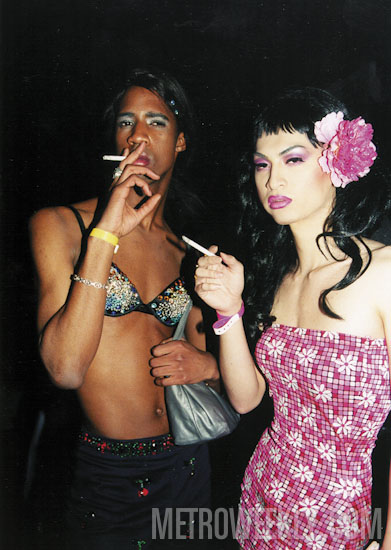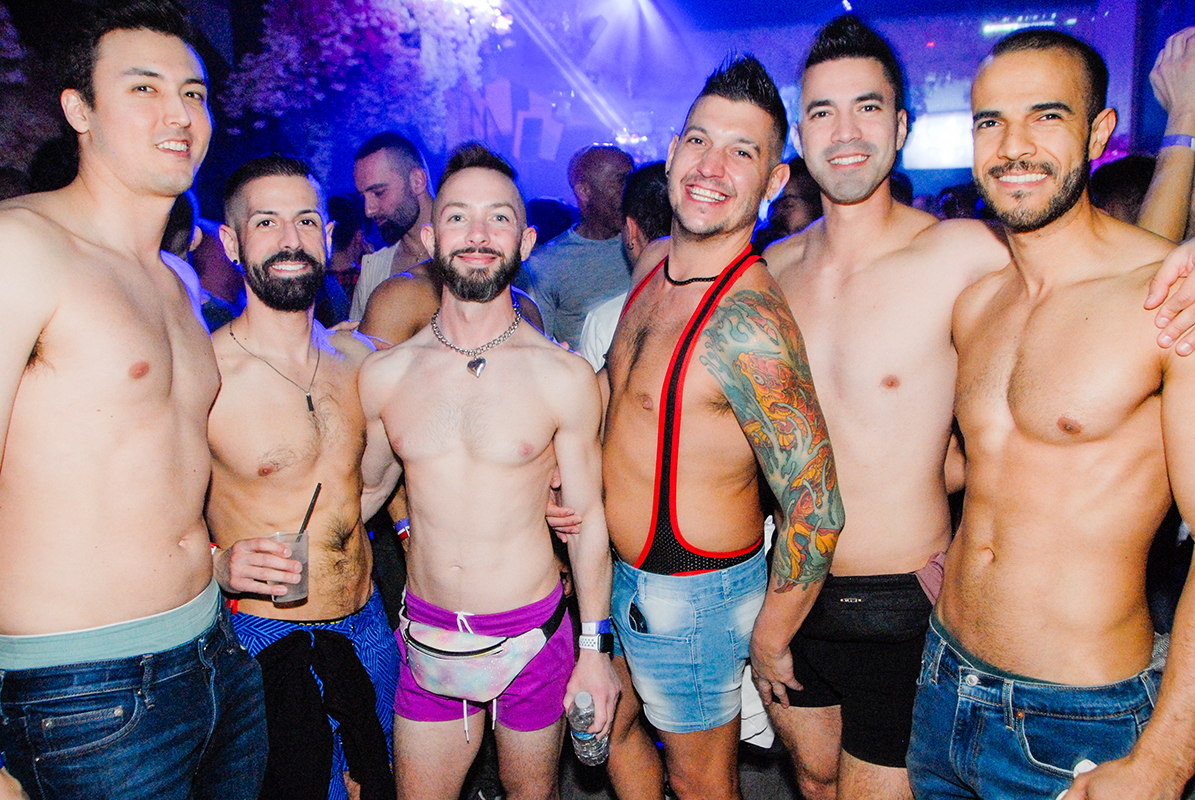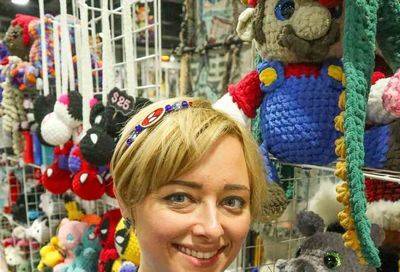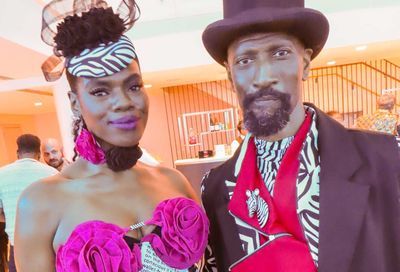Bailey's Crossroad
Venerable nightlife promoter and DJ Ed Bailey cut his teeth working at Tracks. He recalls life at the club he called home for many years.
METRO WEEKLY: What did Tracks mean to you?
ED BAILEY: Tracks was where my passion and my love affair with nightlife and nightclubs started, absolutely. It was the first club that I ever went to. From the very first moment, I was absolutely mesmerized, blown away and hooked. And that was Christmas night 1984.
I went with a bunch of straight friends from high school, who did not know that I was gay. They had been there before. Tracks was made up basically of three areas. It was made up of the small room, which was a video room. It was made up of a patio outside, which was humongous. And it was made up of the main room. Basically there were these three areas. You walked into this kind of central area, and you either went left to the small room, straight ahead to the patio, or to the right to the main room. When we walked in, they all said, ”You want to go this way, to the main room. It’s the safe direction to go.” Which was a reference to it being the straighter area, not where the gay people would be. So this was their advice to me. So we went to the main room.

Ed Bailey photographed at Nation in 2007
(Photo by Todd Franson)
We were on the dance floor and we’re dancing, and I specifically remember that ”Let The Music Play” by Shannon was playing. And the power went out in the building. The power goes out, pitch black. No sound, except the people. Everybody pulling out lighters, flicking on their lighters, matches — there were matchbooks on the bars — and my friends specifically said, ”Quick, get your back up against the wall over here on the dance floor.” And that was also a reference to, there are gay people here. [Laughs.] And it was safer with your back up against the wall. How about that? It was so ridiculous! We were kind of frozen: What do you do? How do you deal with this? It was a little scary, you know, in a big, huge, pitch-black room with fifteen-hundred or so people. And all of a sudden, the crowd started banging out a beat on the railings, and on the walls. And chanting, ”We don’t need no power! We don’t need no power!” And everyone started dancing again. Within maybe five minutes — it seemed at the time like it was 30 minutes. And the power came back on, the music started back up, and everybody cheered as you would expect them to.
That was my first night. That was my first experience. At that point I was absolutely head over heels with this thing, whatever this was — this experience, this nightlife, this vibe, this energy, this thing that I experienced. And I went back to Tracks that following Wednesday. And as a naive, never-having-experience-in-the-club-world type person, as you can imagine I went back expecting it to be exactly the same. But it was a Wednesday, so it wasn’t as busy. And Wednesday night it was a completely African-American house music thing going on. And I showed up and didn’t know. I just knew they were open on Wednesday. And I was like, ”Oh, my God! It’s totally different.” Not in some kind of, ”Oh, I don’t want to be here way,” but in a, ”Oh, my God! It’s even different on different nights.” That’s when that first occurred to me. [Laughs.] There’s even more of a dynamic. That makes it even more intriguing, and even more alluring.
So that was my first moment at Tracks. From there, I went back to college. I was only here for Christmas break, but I came back for spring break, and I went every night that I was here for spring break. And then during the summer. I was so intrigued by it and what it had to offer that it led to me wanting to know about and understand more about being a DJ. And what DJs were about. So I spent time at college teaching myself how to DJ.
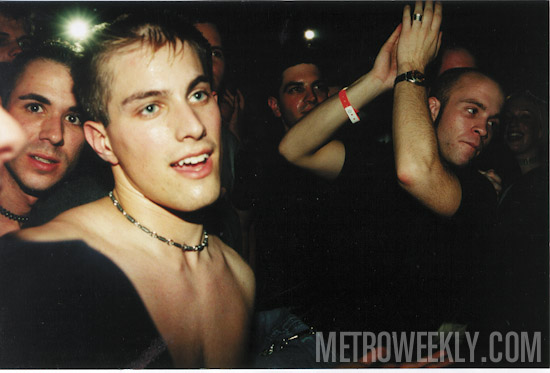
Tracks partiers — Click for more photos
MW: How did you end up working at Tracks?
BAILEY: Over the course of the next couple years, I spent a lot of time going to clubs and going to parties and befriending all of the club people of the city on all the different nights and all the different locations.
At Tracks, I befriended in a very serious way the DJ that was playing in the video room on the weekends at Tracks. His name was Andy Meade. And he was the VJ and DJ at the time. He would play some vinyl and some music video. There was a huge video screen that dominated the room. And in those days it was actual video — VHS tapes. Eventually Andy got promoted at Tracks to be the tech director, in charge of all the technical operations at the club. He said that he thought it would make sense if I just took his shift. And that’s how I actually started working there.
MW: Your role in planning and promotion at Tracks, that started after John Guggenmos and his team started running the club in 1990?
BAILEY: Part of John’s duties within that operational group was to be in charge of the marketing and the DJs. John asked me to become part of the marketing team. To basically be his assistant and help him in the marketing efforts of Tracks. The plan was to establish a marketing presence for Tracks. Because up until that point there had been really no marketing efforts whatsoever, in any kind of large scale way, with regard to Tracks. There were efforts made, but nothing on the scale that John envisioned for the club. And to take advantage of the reality that the world was changing and shifting, and that Tracks could be a part of that.
MW: Yeah, Tracks was a gay club at a time when you didn’t necessarily want to let the world know that — a more closeted, furtive time for gay businesses as well as gay individuals.
BAILEY: Right. And nightclubs in general — it didn’t matter where it was or what it was — nightclubs were kind of secretive and mysterious. But there was a shift in the world in general with regard to marketing anyway. There was just kind of an explosion of marketing that was going on at that time. That’s the ’80s. MTV was born at the same time Tracks was born. And so music video and more of a visual presence of the artist, and more of this kind of awareness, and social awareness of certain things started to come to be at that time. And I say that looking back in retrospect. Obviously we weren’t this savvy about understanding the revolution at the time, but, you look back and you realize, Tracks wasn’t really advertising.
Well, the first thing John did was to procure the back cover of the Blade. He started to craft the vision about how to advertise and market Saturday nights. John created the genesis of marketing and advertising efforts that were done for Tracks. He enlisted a photographer to do photo shoots that would give us imagery to do ads. And we were going to put beautiful, buff guys in these ads. And this was kind of a shift. Up until that point it had always kind of been pictures of the club, or pictures of the logo. But not really photos of guys, or things like that. And this was the shift that Tracks took that kind of grabbed more attention.
So we started to create this schedule of events, around large themes. And those would be the things we would advertise. John was driving that train. He was making that happen. Eventually he became more involved and went to open Trumpets, and I took over the marketing efforts at Tracks.
MW: Were you still DJ’ing and VJ’ing too?
BAILEY: Oh yes, I was still DJ’ing through this whole thing. I had also acquired many other DJ’ing gigs and was playing all over the city.
John made the decision to have me change from being in the small room to being in the big room on Saturday nights. And that was uncomfortable for me, because I was friends with all the DJs. I became the main room DJ.
MW: Dance music and club music changed over the course of the 15 years of Tracks. The music was even changing in the four or five years you were the main room DJ, and also the last few years of Tracks. It was constantly changing.
BAILEY: Especially in the time frame we’re talking about, the clubs were the driving force behind the education of people with regard to music. There was no Internet, there was no mass way for people to know about music other than the radio or nightclubs. And radio wasn’t playing what you were hearing in the clubs. The clubs did not play what you were hearing on the radio. It was very kind of different than what is going on today. The club world existed independent of radio, for the most part.
MW: You’ve had several big nightclubs, or big parties, since Tracks — including Ozone, Velvet Nation and most recently Town. Looking back on Tracks, how would you say it was unique among your ventures?
BAILEY: Tracks was unique in the sense that — this is a big answer because it was unique. There was nothing like Tracks. Tracks was a gay club, but everybody in the city went there. That was unique in and of itself. Up until that point in history, there were no gay clubs where straight people went. Gay clubs were for gay people. Tracks became this melting pot of people who appreciated the fact that this was the most technologically advanced, the largest scale, grandest party experience that you could have. It was the largest and flashiest experience that you could go and experience in D.C., or anywhere up and down the East Coast from New York down. It was unique because of the people. It was unique because of the facility. And it was unique because of the time in which it existed — it was a moment where gay people were starting to move out of the shadows, with regards to the gay parts of their lives; the things they did that would allow them to identify as gay.
Tracks was the first place that kind of became all-inclusive at a time when that was starting to become something that was okay. And it was offering this product that was cutting edge: It was the pinnacle in the effort of the music. It was the pinnacle in the effort of the light show; the first computerized light show of any nightclub. It was the pinnacle in the sense of a sound system. It was the pinnacle in the sense of just the grand scale of the club. All of these things coming together made this such a unique experience. And then people’s idea of what a nightclub was, which in general was something that was a little bit darker, a little bit dirtier, a little bit seedier — that definition had to evolve because this club changed that definition. There was a huge outdoor component to this club. Not just a patio; a huge patio. I’m going to guess it was a 4,000-, maybe 5,000-square-foot patio that included a dance floor. It included a volleyball court. It included a barbecue pit. It included a fountain that was kind of a wading pool, that you could sit on the edge of with your feet in the water. With bleacher seating that surrounded this volleyball court so you could sit and watch people play volleyball. With all of this lounge seating throughout. There was a huge snack bar. So you could eat all kinds of food. As it got later in the morning hours, 4, 5 o’clock in the morning, we would make breakfast food. So there would be eggs and toast and bacon. [Laughs.]
MW: As I understand it, the appeal of nightlife for you is not substances — no drugs, including alcohol. You don’t drink, you don’t smoke.
BAILEY: I’ve never done any drugs. I’ve never smoked. And, I drank, a little bit. That was the result of a boy — it’s always about a boy — who I met who drank and so I wanted to think I was cool, so I drank a little bit. That lasted for all of a couple years in the mid- to late-’80s. The thing about my life at Tracks and my experience was, there are a lot of people that do a lot of things that I don’t do. And whether that be any of those things, or other stuff, that was kind of the thing that [made] Tracks interesting. It was just a big learning experience, a big social experience, of putting a lot of different kinds of people in one place, to have one common way of enjoying themselves. It brought people together that were very different, and it just created this tribal feeling — this moment where you all come together, and you became aware of your shared commonality, as opposed to the differences that you have.
For a lot of people there is an association with drug use and nightclubs, and frankly, I know that that exists. Obviously. But it is not the biggest proponent. Nightclubs do not exist to be a big room for people to be able to do drugs. That’s not true. It is a perception that’s not as accurate I think as people have portrayed it to be over the years. Nightclubs are a place for people to go to socialize and enjoy the company of other people. And some people do that and take drugs, that’s true. Some people do that and drink, that’s true. But there are also people that just enjoy the music. That just actually enjoy dancing. Who actually enjoy being out with other people. And those people outnumber the people who are partying. And they always have.
Tracks was this very inviting atmosphere that made me realize that, hey, we should all be able to do whatever we want to do. It’s totally cool. As long as nobody’s hurting each other, what’s the big deal?
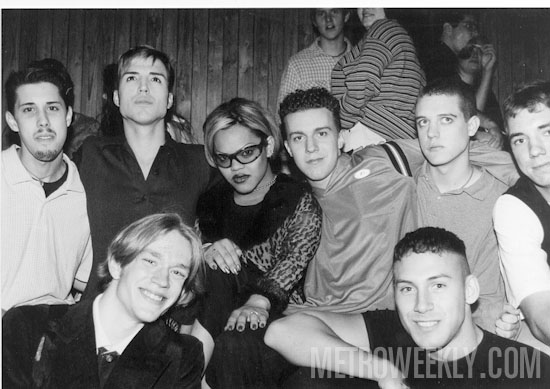
Bonding on the bleachers — Click for more photos
MW: That could have been partly a reflection of the time. Ecstasy, in particular, was created and took off during Tracks’ reign.
BAILEY: That’s correct, you’re absolutely right. I think one could do a linear history of the evolution of club drugs. There have always been some level of something done, whether it’s alcohol, or whether it’s some other kind of drug, throughout the history of nightclubs going all the way back to the early 1900s. And a lot of people have said, and I don’t disagree with this, that ecstasy was maybe the perfect drug to exist at the perfect time that Tracks was going on. This melting pot of all these people, and this kind of new acceptance in a general way of gay people. I just really didn’t understand what was going on with that and the drugs and all of that. It’s not something I was really conscious of.
MW: Facebook is essentially how this Tracks Reunion came into being.
BAILEY: That is correct, that is correct. The reunion came to be through a groundswell of people feeling the emotion, and the tide to Tracks, and just this thing that I think we all feel that Tracks was. And people started connecting and sharing these thoughts, and how great it was, and that just evolved to a greater level to, we ought to try to have some kind of reunion. And of course when there’s something like a high school or a college, there’s more of a structure in a way to have a reunion. When there’s something like this, there was no obvious way for a reunion to exist, because there was no kind of organizing body that could do it. There was just this kind of nebulous Facebook group. And so Patrick Little, being the kind of guy that he is, he started to work through how that might happen, and he approached me during that process, and enlisted my advice, and I was more than happy to give it to him. In the same way that when Tracks closed I was more than happy, I was flattered that they approached me and asked me to be part of the closing party. And that meant so, so much to me, because I understood that I had left there, and being at Nation was clearly part of the reason why Tracks got to a point where maybe the right decision was for it not to keep operating. That always felt awkward to me, because Tracks was so important. That my being in any way involved in the process that damaged that was always very difficult for me. I was always very conflicted over that. And it was really amazingly flattering and humbling that they approached me to even be part of the closing night.
And those are the same feelings that I had when Patrick came to me to say, hey, do you think this is something you might want to help me with? We talked long and hard about it, because it’s a very complicated concept to do this kind of a thing. People have memories that are very strong and powerful. To have an event that tries to somehow pay homage to those memories is a daunting task to live up to that. So we just did what we thought we could do to pay homage to the music, which meant a lot to people. But to also be sure to let people know that we’re not trying to re-create Tracks, but that we’re trying to just give people an opportunity to see each other again; to share stories and memories and see familiar faces, and relive some moments, and hear some music that might take them back a little bit. And try to compartmentalize that into multiple events because we couldn’t have made that happen in one event.
The Tracks Reunion starts on Friday, April 26, at 9 p.m., at DC9, 1940 9th St. NW. Tickets are $10. Call 202-483-5000 or dcnine.com. A Cocktail Mixer, Memorabilia Display and Silent Auction is Saturday, April 27, at 6 p.m., followed by the main event dance party at 10 p.m., at Town Danceboutique, 2009 8th NW. Cover is $10, or $12 after 11 p.m. Call 202-234-TOWN or visit towndc.com. The weekend wraps on Sunday, April 28, at 9 p.m. at Phase 1 of Dupont, 1415 22nd St. NW. Cover is $10. Call 202-974-6832 or visit phase1dupont.com. For more information visit tracksdc.com.
Read more about Tracks Reunion Weekend:
Support Metro Weekly’s Journalism
These are challenging times for news organizations. And yet it’s crucial we stay active and provide vital resources and information to both our local readers and the world. So won’t you please take a moment and consider supporting Metro Weekly with a membership? For as little as $5 a month, you can help ensure Metro Weekly magazine and MetroWeekly.com remain free, viable resources as we provide the best, most diverse, culturally-resonant LGBTQ coverage in both the D.C. region and around the world. Memberships come with exclusive perks and discounts, your own personal digital delivery of each week’s magazine (and an archive), access to our Member's Lounge when it launches this fall, and exclusive members-only items like Metro Weekly Membership Mugs and Tote Bags! Check out all our membership levels here and please join us today!




